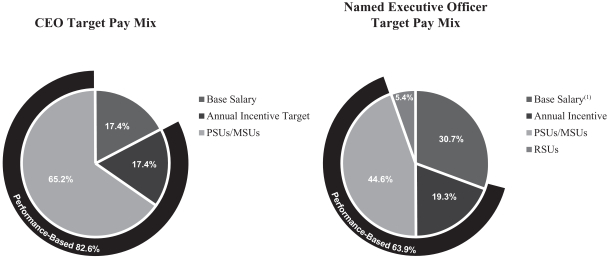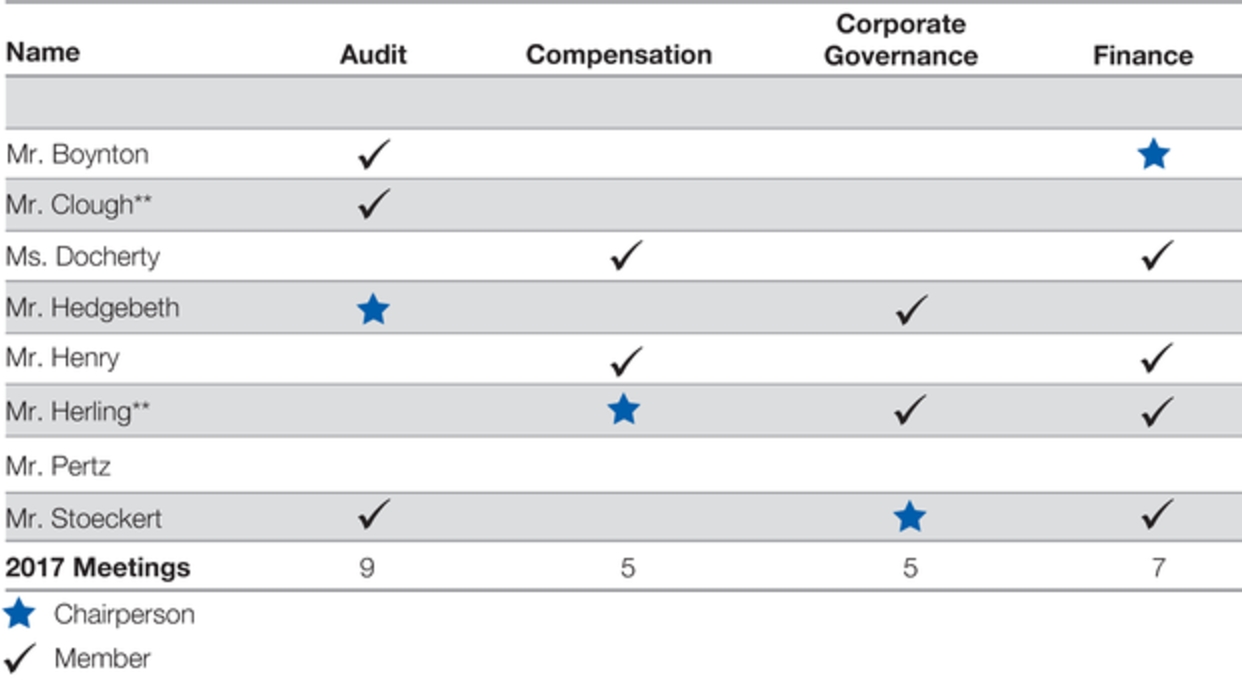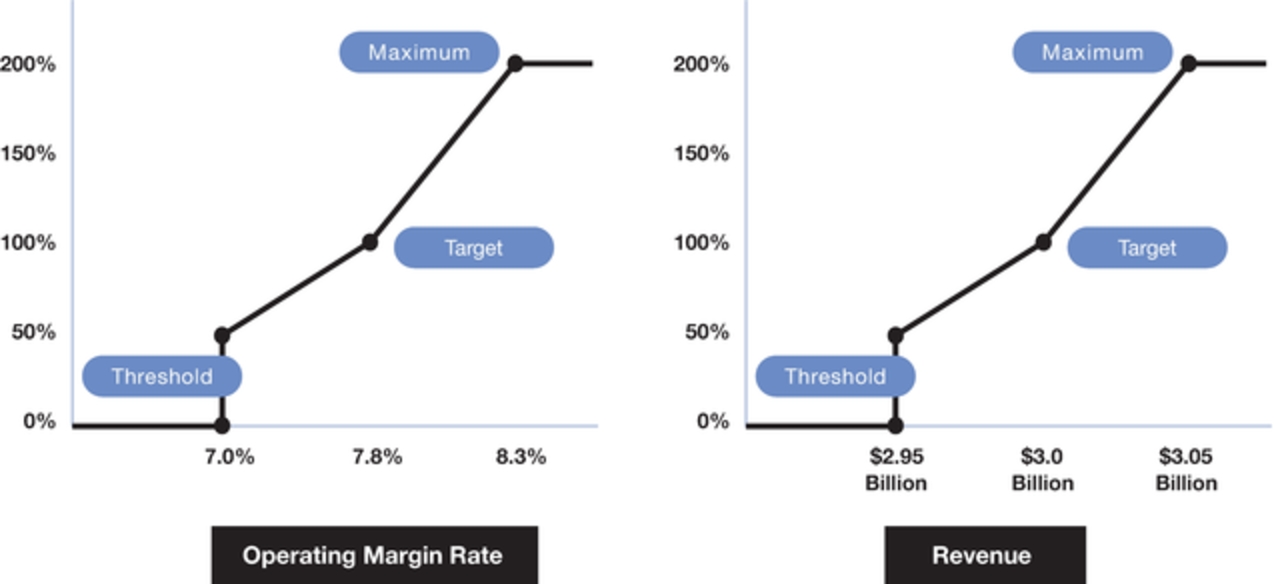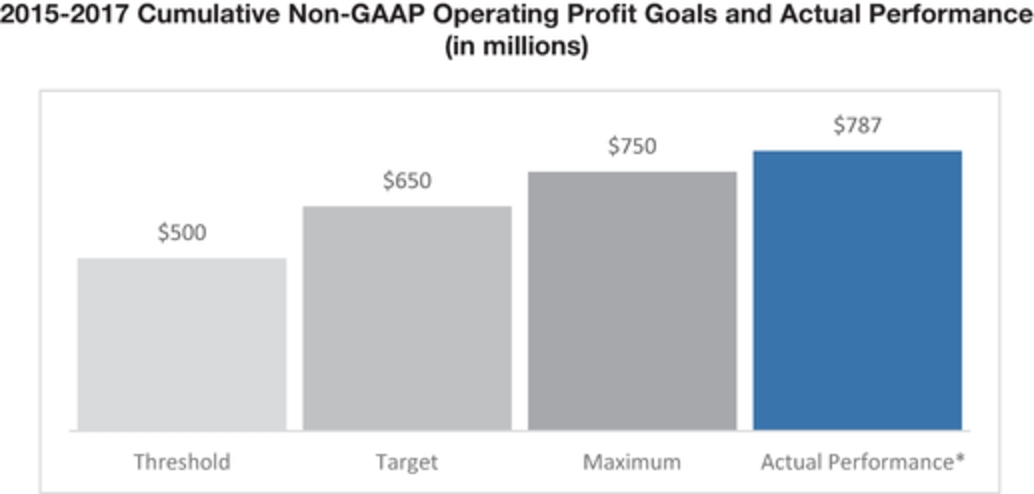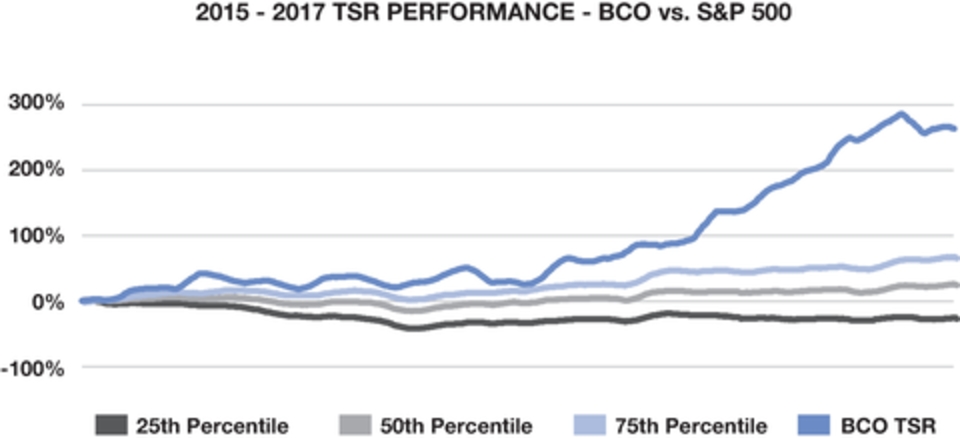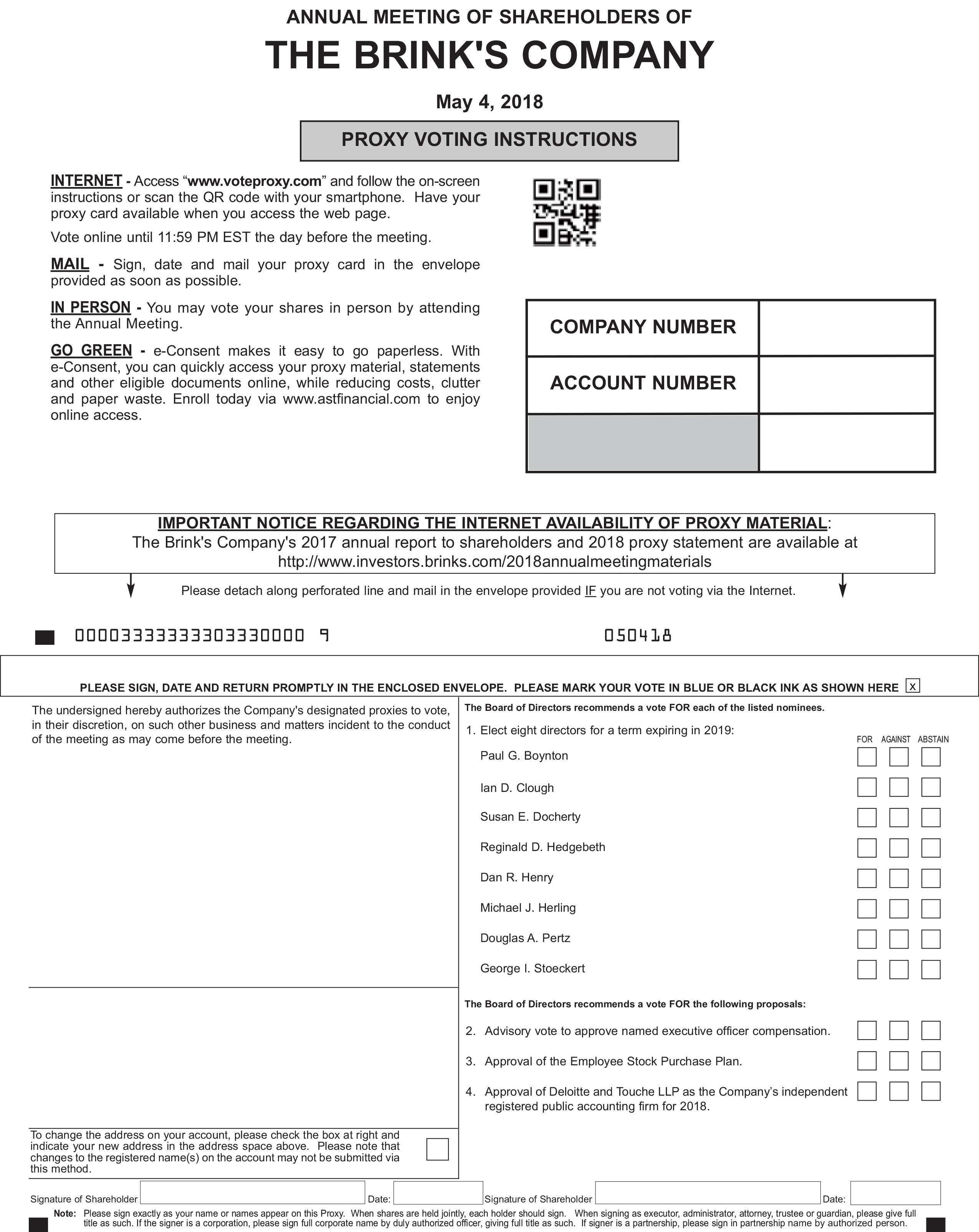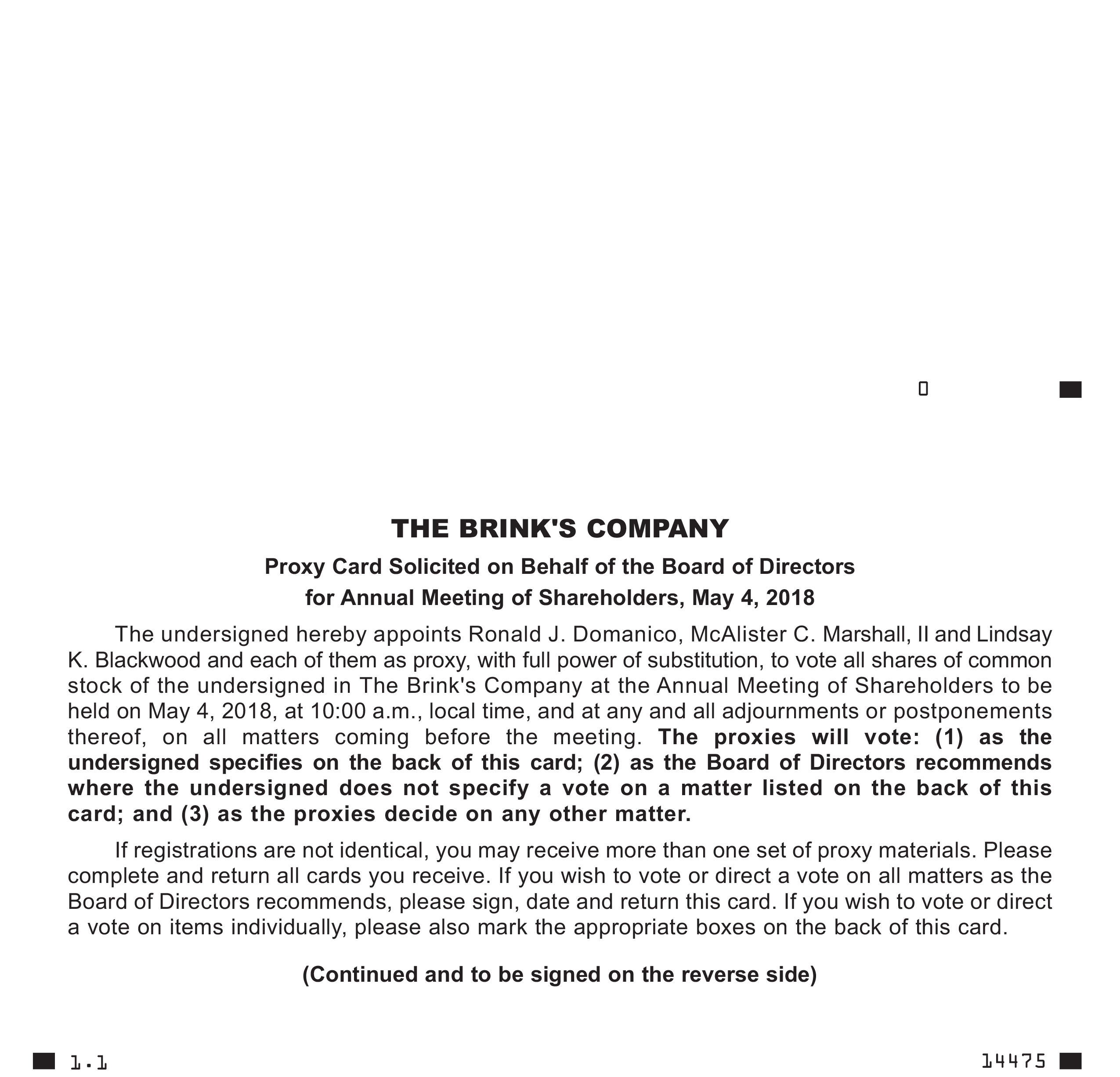Non-GAAP ReconciliationsTHE BRINK’S COMPANY EMPLOYEE STOCK PURCHASE PLAN
This proxy statement refers1. Purpose. The Brink’s Employee Stock Purchase Plan (the “Plan”) is intended to segment operating profit, which isprovide employees of the Company and its Participating Subsidiaries with an opportunity to acquire a financial measureproprietary interest in the Company through the purchase of shares of Common Stock. The Company intends that the Plan qualify as an "employee stock purchase plan" under Section 423 of the Code and the Plan shall be interpreted in a manner that is not required byconsistent with that intent.
2. Definitions.
“Board or presented in accordance with U.S. generally accepted accounting principles (“GAAP”). Segment operating profit includes the allocation of regional management costs under the Company’s reporting structure in effect prior to the 2014 Reorganization and Restructuring. The purpose of the Non-GAAP results is to report financial information excluding certain income and expenses. The Non-GAAP information provides information to assist comparability and estimates of future performance. Brink’s believes these measures are helpful in assessing operations and estimating future results and enable period-to-period comparability of financial performance. In addition, Brink’s believes the measures will help investors assess the ongoing operations. Non-GAAP segment operating profit should not be considered as an alternative to operating profit determined in accordance with GAAP and should be read in conjunction with its GAAP counterpart.
| | | | | | | | | | | | |
| (In millions) | | Total
Segment
Profit (Loss) | | | Non-Segment | | | Total
Operating
Profit (Loss) | |
Full Year 2014 | | | | | | | | | | | | |
GAAP | | $ | 24.3 | | | $ | (51.8 | ) | | $ | (27.5 | ) |
FX devaluation in Venezuela | | | 142.7 | | | | — | | | | 142.7 | |
2014 Reorganization and Restructuring | | | 21.8 | | | | — | | | | 21.8 | |
Acquisitions and dispositions | | | (4.5 | ) | | | (44.9 | ) | | | (49.4 | ) |
Mexican settlement losses | | | 5.9 | | | | — | | | | 5.9 | |
U.S. retirement plans | | | 25.2 | | | | 47.9 | | | | 73.1 | |
Share-based compensation adj. | | | 0.9 | | | | 1.5 | | | | 2.4 | |
| | | | | | | | | | | | |
Non-GAAP | | | 216.3 | | | | (47.3 | ) | | | 169.0 | |
| | | |
Full Year 2013 | | | | | | | | | | | | |
GAAP | | $ | 244.3 | | | $ | (81.1 | ) | | $ | 163.2 | |
FX devaluation in Venezuela | | | 14.6 | | | | — | | | | 14.6 | |
Acquisitions and dispositions | | | (3.0 | ) | | | (2.8 | ) | | | (5.8 | ) |
Mexican settlement losses | | | 2.4 | | | | — | | | | 2.4 | |
U.S. retirement plans | | | 11.6 | | | | 41.3 | | | | 52.9 | |
| | | | | | | | | | | | |
Non-GAAP | | | 269.9 | | | | (42.6 | ) | | | 227.3 | |
FX devaluation in Venezuela The rate we use to remeasure operations in Venezuela declined 16% in February 2013 (from 5.3 to 6.3 bolivars to the U.S. dollar) and 88% in March 2014 (from 6.3 to 50 bolivars to the U.S. dollar). Expenses related to remeasured net monetary assets were $121.6 million in 2014 and $13.4 million in 2013. In addition, nonmonetary assets were not remeasured to a lower basis when the currency devalued. Instead, under highly inflationary accounting rules, these assets retained their higher historical bases, which excess is recognized in earnings as the asset is consumed resulting in incremental expense until the excess bases are depleted. Higher expenses related to nonmonetary assets were $21.1 million in 2014 and $1.2 million in 2013. Expenses related to these Venezuelan devaluations have not been allocated to segment results.
2014 Reorganization and Restructuring Brink’s reorganized and restructured its business in December 2014, eliminating the management roles and structures in its former Latin America and EMEA regions and is substantially complete with implementing a plan to reduce the cost structure of various country operations by eliminating approximately 1,700 positions across its global workforce. Severance costs of $21.8 million associated with these actions were recognized in 2014. These amounts have not been allocated to segment results.
Mexican settlement lossesEmployee benefit settlement losses in Mexico have not been allocated to segment results.
Acquisitions and dispositions Gains and losses related to acquisitions and dispositions that have not been allocated to segment results are described below:
Brink’s sold an equity investment in a CIT business in Peru and recognized a $44.3 million gain in 2014. Other divestiture gains in 2014 were $0.6 million. Equity earnings related to our former investment in Peru recognized in prior periods ($3.8 million in 2014 and $6.1 million in 2013).
Adjustments to the 2010 business acquisition gain for Mexico ($0.7 million favorable adjustment in 2014 and a $1.1 million in unfavorable adjustments in 2013).
Adjustments to the purchase price of the January 2013 acquisition of Rede Trel in Brazil ($1.7 million of favorable adjustments in 2013).
The $0.9 million impairment in 2013 of an intangible asset acquired in the 2009 India acquisition.
U.S. retirement plansBrink’s retirement plan benefits in the U.S. are frozen and the related expenses have not been allocated to segment results. Brink’s primary U.S. pension plan settled a portion of its obligation in the fourth quarter of 2014 under a lump sum buy-out offer. Approximately 4,300 terminated participants were paid about $150 million of plan assets under this offer in lieu of receiving their pension benefit. A $56 million settlement loss was recognized as a result of the settlement.
Share-based compensation adjustmentAccounting adjustments related to share-based compensation have not been allocated to segment results ($4.2 million expense in the second quarter of 2014 and a $1.8 million benefit in the third quarter of 2014). The accounting adjustments revise the accounting for share-based compensation from fixed to variable fair value accounting as defined in ASC Topic 718,Stock Compensation.
Appendix B
AMENDED AND RESTATED ARTICLES OF INCORPORATION
of
THE BRINK’S COMPANY
ARTICLE V
1. The Board of Directors shall consist of such number of individuals, not less than eight or more than thirteen, as shall be specified in or fixed in accordance with the bylaws of the Corporation. Directors may be removed only with cause.
2.Directors shall be divided into three classes, each class to be as nearly equal in number as possible, the number to be assigned each class to be determined by, or in the manner provided in, the bylaws of the Corporation, or in the absence of any such provision, then by the Directors prior to the election of a particular class. At each annual meeting the successors to directors whose terms shall expire that year shall be elected to a term of three years. Until the 2018 annual meeting of shareholders, the directors shall be divided into three classes as nearly equal in number as possible. Without limiting the term of any director elected at or prior to the 2015 annual meeting of shareholders, at any annual meeting of shareholders to be held in each of 2016 and 2017, directors standing for election shall be elected for terms expiring at the first annual meeting of shareholders following the director’s election. Commencing with the annual meeting of shareholders in 2018, the classification of directors shall cease and at such annual meeting and at each annual meeting thereafter, directors elected to” means the Board of Directors shall hold office untilof the first annual meetingCompany, as constituted from time to time.
“Code” means the U.S. Internal Revenue Code of shareholders following1986, as it may be amended from time to time. Any reference to a section of the director’s election. Each year the annual meeting of shareholdersCode shall be helddeemed to include a reference to any regulations promulgated thereunder.
“Committee” means the Compensation and Benefits Committee or such other Committee or Subcommittee appointed by the Board to administer the Plan.
“Common Stock” means the common stock of the Company, par value $1.00 per share.
“Company” means The Brink’s Company, a Virginia corporation, including any successor thereto.
“Salary” means fixed compensation paid to an Eligible Employee by the Company or a Participating Subsidiary as compensation for services to the Company or Participating Subsidiary, before deduction for any salary deferral contributions made by the Eligible Employee to any tax-qualified or nonqualified deferred compensation plan (or equivalent plan or program outside the U.S.), including but not limited to overtime, vacation pay, holiday pay, jury duty pay and funeral leave pay, excluding but not limited to imputed income arising under any group insurance or benefit program, variable pay such as travel expenses, business and relocation expenses, incentive or bonus compensation, and income received in connection with stock options or other equity-based awards.
“Corporate Transaction” means a merger, consolidation, acquisition of property or stock, separation, reorganization or other corporate event described in Section 424 of the Code.
“Designated Broker” means the financial services firm or other agent designated by the Company to maintain ESPP Share Accounts on behalf of Participants who have purchased shares of Common Stock under the Plan.
“Effective Date” means the date as of which this Plan is adopted by the Board, subject to the Plan obtaining shareholder approval in accordance with Section 19.11 hereof.
“Employee” means any person who renders services to the Company or a Participating Subsidiary as an employee pursuant to an employment relationship with such employer. For purposes of the Plan, the employment relationship in the United States shall be treated as continuing intact while the individual is on military leave, sick leave or other leave of absence approved by the Company or a Participating Subsidiary that meets the requirements of Treasury Regulation Section 1.421-1(h)(2). Where the period of leave exceeds three (3) months, or such other period of time specified in Treasury Regulation Section 1.421-1(h)(2), and the individual's right to re-employment is not guaranteed by statute or contract, the employment relationship shall be deemed to have terminated on the first Fridayday immediately following such three-month period, or such other period specified in MayTreasury Regulation Section 1.421-1(h)(2).
“Eligible Employee” means, consistent with the requirements of Section 423 of the Code, an Employee of the Company or its subsidiaries on a full or part-time, but not seasonal, basis . Notwithstanding




 2018 Proxy Statement | 1
2018 Proxy Statement | 1
